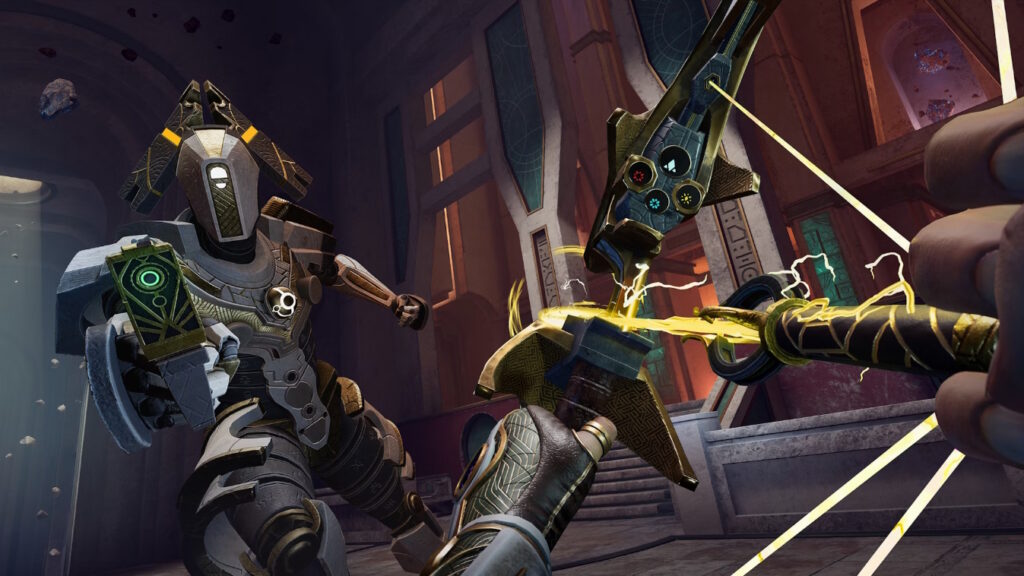With nDreams looking to revolutionise VR action games once more with the release of Reach on Thursday this week, and following my hands on session with the game, I had a chance to sit down with Glenn Brace, Head of the studio to chat about Reach and find out exactly why those death defying leaps don’t make you want to reach – aha! – for the sick bag.
TSA: Please introduce yourself and explain how you came to be working on Reach.
Glenn: My name’s Glenn Brace, and I’m the head of studio for Elevation, and a living, breathing VR evangelist. Long story short, I’ve been in games devs for like 20 years but there’s only so many generations of platforms you can go through with the same IPs, so when VR arrived, that was for me the true next-gen. This is a new frontier, there’s new things. It doesn’t matter if you’re a mega studio or a little studio. The innovation is just there for the sake of it.
More recently, I wanted to get back closer to development, back to what is the best for VR. So nDream Elevation was born. The studio was created to look at the future, work on the sort of tech leading to VR innovation and where VR is going. We are the driving core tech, leading that core tech in the rest of the business. The rest of the business can use that and elevate themselves from that, but we are pushing that. We’re making the new stuff.
When we started the studio for this game, we started with the goal of reinterpreting action adventure for VR. That was the goal. We had a hypothesis, which was that we believe through one-to-one physical action simulation, you will have more immersion and therefore more presence. And more immersion presence means it’s more emotional. The more emotional games, the more memorable, the more fun. So, that was the hypothesis.
We set off and set ourselves a task, “Right, let’s discover one-to-one control and prove to ourselves if it truly is agency granting”. So, we tried different jumps, we tried running, how you fail and fall, what is the believability of you as a character. There’s so many metrics to discover.

TSA: Give me the Elevator pitch for Reach.
Glenn: Essentially, it’s action-adventure reimagined for VR. And the root of that is absolute agency-granting, second-to-second role play. What does that mean? That is a translation from the famous genres that we love, such as Tomb Raider. All those games out there that we’ve loved before in the past, but brought into VR, how does that work? We know there will be challenges doing it, but we’re going to fix those challenges and bring the essence of role play to that genre for VR. It’s run, jump, swing, fling. It’s action adventure in the true sense and giving that power to the player.
TSA: Where did the original idea come from? You mentioned Tomb Raider.
Glenn: So it’s definitely an influence of what we’re trying to capture, but I think what’s really important about our game is aas a translation of the action adventure genre. So I wouldn’t go into it thinking we’ve made a Tomb Raider – we haven’t – it’s very much what needs to be, different. For starters going first person is in itself a big change. Historically, cinematics have played a large part in that genre, but we don’t want to break the immersion, so even the nature of that format needs to change.

TSA: I played a good hour and a half and it felt like half the time, and not once did I feel any sort of motion sickness or dizziness despite all the running and jumping, how on earth have you managed that?
Glenn: So, comfort was a big thing, and we set out to tackle that. One of the key factors of that was ‘FBA’, full body awareness, one of the key components. It’s not just to render the body and see it in game, although that’s cool, it’s that we have more than the tracking points. We simulate the wrist, the arm angle, we simulate the elbows, we simulate the body, the hips, the shoulders, the neck. When we have all that information, it makes things like mantling so much smoother and more reliable. That allows flow, it allows proper parkour, player-driven you’re-in-control flow.
That extends into jumping as well. If you get a motion that you’re not in control of it can send you over the edge. So for jumping, you actually move your arms as if you are about to take leap in real life to start the jump in-game, and this fools your body in to thinking your are actually doing it.
Another natural thing is when you jump over an edge, you look where you land, you look down, and you can tune the arc of the land specifically on that tight pillar. It feels natural; you do it in a very natural way. So, again, it’s more comfortable. Suddenly, we’ve got a level of parkour and jumping platforming that is super cool.
We also simulate body mass and weight, and that comes back to how you play traditional platforming. Once you familiarize yourself with your body mass and weight, how you use it, you can become skilful in platforming, and therefore in control. When you put those things together, the realization of it, the sense of weight, the sense of mass, the physics of it, the aftertouch, you’ve got a new experience in VR.
One of the goals I always wanted, and I always say this, was to make someone role-playing act in the interest of self-preservation. Faced with a giant leap, will you stop and think, “I’m not going to jump on that. No way. I’m going to do this”? In a standard game you’d do it anyway, you will die, start again, do it, die, start again. We wanted the players to be in the moment and think, making them prioritise their sense of survival in that world.

TSA: So, given that every action adventure game these days gets a TV show or film, who would direct the Reach movie?
Glenn: Well, I can tell you, not Michael Bay! We started Reach with the idea that it’s going to be action-packed, but the reality is the emotions and the moments, they’re a lot smaller, a lot more contained. So, I think it’s a more intimate experience now than when we first set out. So, I need to find a director that’s kind of in touch with the emotional side. Who did the Star Wars film everyone really liked?
TSA: Rogue One? Gareth Edwards.
Glenn: Yeah, I’ll go with Gareth Edwards. He did also Monsters which could have been a big loud film but it was actually quiet and poignant. So, yeah, I would go with Gareth Edwards.
Thanks to Glenn for speaking to us about this fascinating project. Reach launches on 16th October 2025 on PS VR2, MetaQuest, and PC VR. Players who pre-order from the Meta Horizon Store or PlayStation Store any time from now until launch will receive the Ferran cosmetic set which includes a Traditional Ferran outfit, Ornate Bow, Ferran Guard Shield, Traditional Gauntlets and Ornate Drone.



